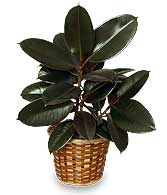Ask The Expert: i was given a rubber plant at my fathers furneral and i do not have good luck with plants.i live in the country and have a high ph in my water as well as other minerals,should i get water from town or distilled water.and it was a large plant when i got it and its roots look weird to me i mean i can see them up at the top above the dirt ,is this normal?and i am not sure i get what is meant by root ball when replanting.anyway i really want to keep this plant but if it would be better off in town i could give it to my mother.please help lorrie

Flower Shop Network Plant Expert Reply:Well water is usually fine for houseplants. That is unless your water ph is over 7 or your mineral content is way out of line. If you can drink your well water, you should be ok to use it.
The rootball is the mass of soil and roots attached to the base of the plant. Most plants want their roots to be covered, yet they don’t like soil pile up against their trunks. However, it sounds like your plant needs more soil to cover the roots. You need about a 1/4″ of soil covering the roots. You can do this by simply adding a little soil to your container or you can completely re-pot the plant. Do not pile soil up against the trunk.
Since you are new to Rubber Plants (Ficus elastica), you might want to follow these Rubber Plant Care tips:
- Keep the plant moist but not soggy. Rubber plants love a humid environment, so mist the air area around them every few days. Be sure to use luke warm water when misting.
- Give them light. Rubber plants like a lot of light just not all-day direct light.
- Be sure to feed them. A general purpose water soluble fertilizer will work.
For more in-depth information go to our Rubber Plant Care Instruction page.
One more tip: Don’t be surprised if it drops some leaves. Anytime you move Rubber plants from one location to another, they go through transplant shock. If you follow the rubber plant care tips, the plant will bounce back in couple of weeks.


 Find Your
Find Your 

